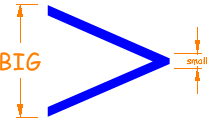Introduction to Inequalities
Inequality tells you about the relative size of two values.
Mathematics is not always about "equals"! Sometimes you only know that something is bigger or smaller
Example: Alex and Billy have a race, and Billy wins!
What do we know?
We don't know how fast they ran, but we do know that Billy was faster than Alex:
Billy was faster than Alex
We can write that down like this:
b > a
(Where "b" means how fast Billy was, ">" means "greater than", and "a" means how fast Alex was)
We call things like that inequalities (because they are not "equal")
Greater or Less Than
The two most common inequalities are:
Symbol
|
Words
|
Example Use
|
|---|---|---|
>
|
greater than
|
5 > 2
|
<
|
less than
|
7 < 9
|
They are easy to remember: the "small" end always points to the smaller number, like this:

Greater Than Symbol: BIG > small
Example: Alex plays in the under 15s soccer. How old is Alex?
We don't know exactly how old Alex is, because it doesn't say "equals"
But we do know "less than 15", so we can write:
Age < 15
The small end points to "Age" because the age is smaller than 15.
... Or Equal To!
You can also have inequalities that include "equals", like:
Symbol
|
Words
|
Example Use
|
|---|---|---|
≥
|
greater than or equal to
|
x ≥ 1
|
≤
|
less than or equal to
|
y ≤ 3
|
Example: you must be 13 or older to watch a movie.
The "inequality" is between your age and the age of 13.
Your age must be "greater than or equal to 13", which would be written:
Age ≥ 13
Equal, Greater or Less Than
As well as the familiar equals sign (=) it is also very useful to show if something is not equal to (≠) greater than (>) or less than (<)
These are the important signs to know:
| = |
When two values are equal, we use the "equals" sign
| example: 2+2 = 4 |
| ≠ |
When two values are definitely not equal, we use the "not equal to" sign
| example: 2+2 ≠ 9 |
| < |
But when one value is smaller than another, we can use a "less than" sign.
| example: 3 < 5 |
| > |
And when one value is bigger than another, we can use a "greater than" sign
| example: 9 > 6 |